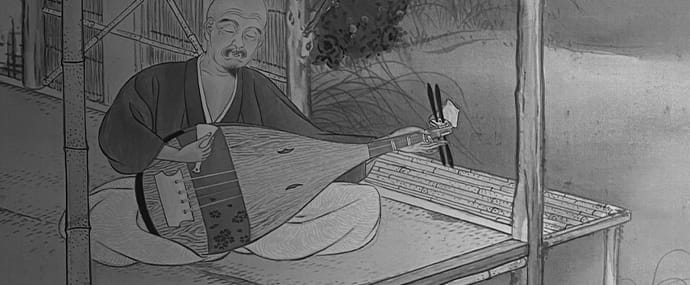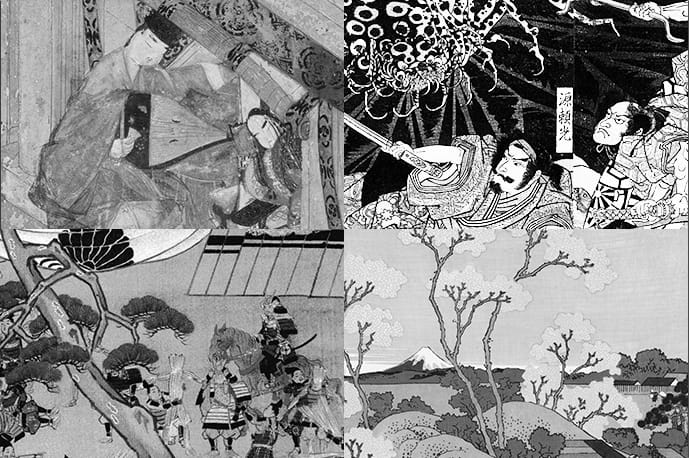1. Size, Material and Shape
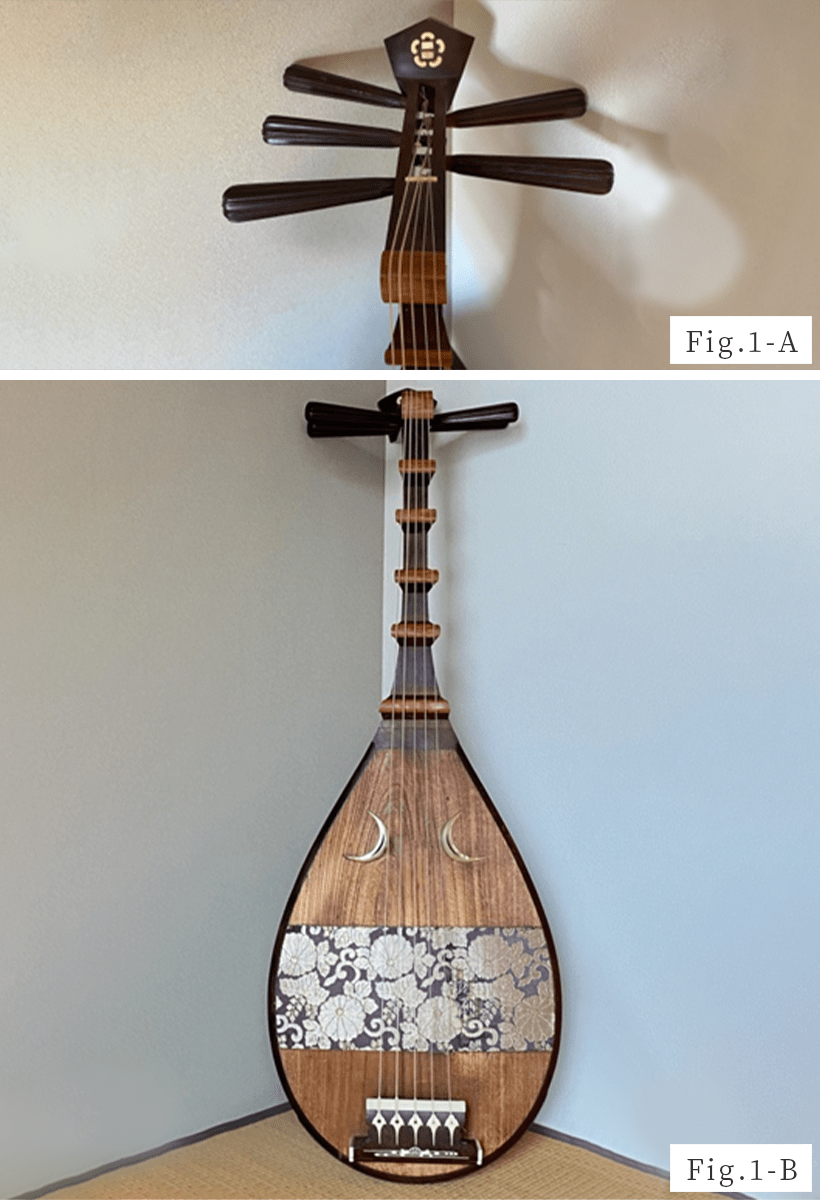
1. Size, Material and Shape
The dimensions of the instrument are variable; a small instrument for a woman with a high voice is approximately 30 cm wide and 90 cm high, this measurement including the tail-shaped end of the pegbox (see Fig. 1-A). An instrument for a deep male voice, however, is approximately 35 cm wide and 105 cm high(see Fig. 1-B).
The instrument can be dismantled into three parts; 1. sound box, 2. neck and 3. pegbox. The biwa has two crescent-shaped resonance openings called “halfmoon”, or hangetsu in Japanese, on the soundboard, as do all biwa types in principle, if with different designs. The holes are thin slits. The most important resonance opening, a round hole, is hidden under the tailpiece (see Fig. 2-A) and is called "hidden moon" ingetsu, or sometimes also “full moon”, or mangetsu, to form a pair with “halfmoon” hangetsu.
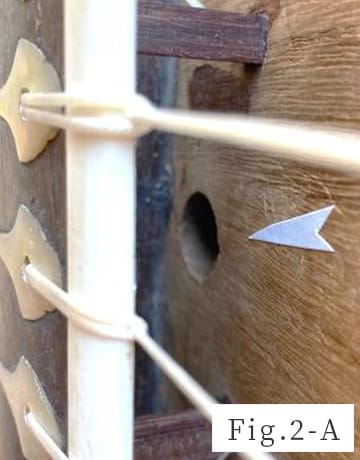
The best and most precious material for all parts is mulberry wood kuwa, the best kuwa being from old trees, which is very hard. What is important - and a decisive difference from all other biwa types - is that the soundboard is carved from soft paulownia wood kiri.
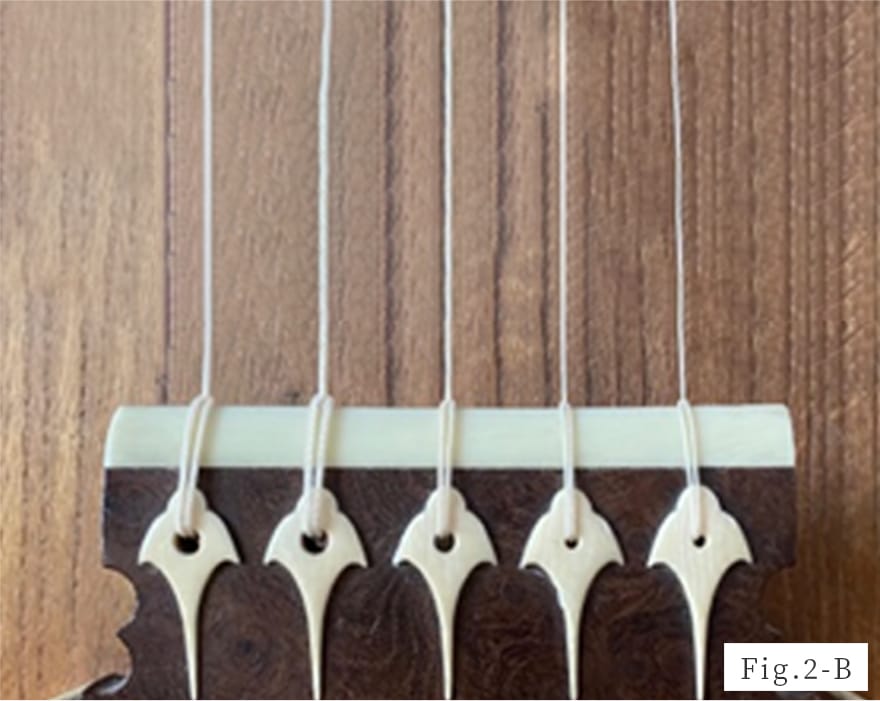
Ivory is commonly used for the crescent moons of the resonance openings and the decorations around the eyelets (see Fig. 2-B) at the bottom on the bridge fukuju where the strings are tied. A plate of susutake, bamboo hardened in smoke, is applied to the top of five frets and on the noritake, the bent section at the end of the neck where the strings enter the pegbox. The susutake plays an extremely important role in creating the unique sound of the chikuzen biwa, which is distinguished by a distinct drone or buzz known as sawari. Players have different ideals of sawari that changes according to their vocal qualities. For this reason, the players are expected to adjust the sawari on their own, which is accomplished with a precise, wafer-thin lengthwise cut on the slightly curved bamboo surface. The darkened brown zone on the top of the bamboo-plate is the sawari area (see Fig. 3).
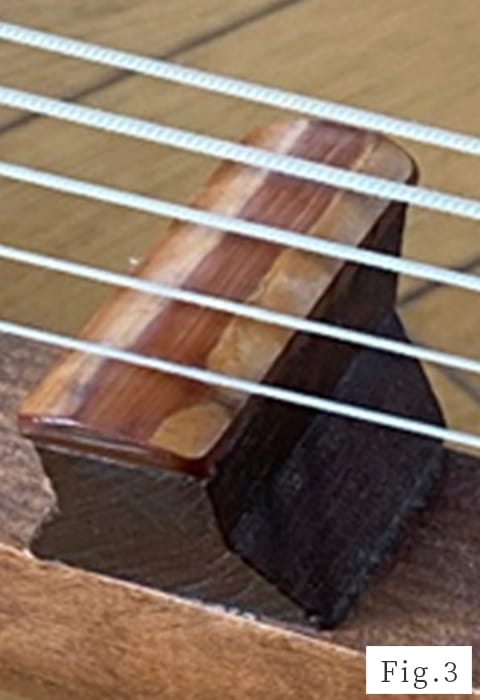
Most performers now ask a biwa-craftsman to perform the sawari cut as this is a delicate operation. Good susutake is now expensive, and the one-time cut with a straight chisel by an amateur can easily go wrong ruining the surface: a costly mistake!
The frets are glued to the surface and sometimes fall off if the instrument is improperly handled. Their replacement on the instrument neck is easy with the fifth and fourth structure of the tuning, only the 1st fret has a special position (see discussion below in chapter 2.2.).
Sometimes, the five pegs are made of a different wood than the instrument body. Above all, it is important that pegs, or itomaki, are solid, as a broken peg cannot be repaired on the spot, and renders performance completely impossible. The fit with the peg box holes is an equally delicate matter: if the peg is too loose, the string will quickly go out of tune while playing; if it is too tight, it is difficult to adjust while playing.
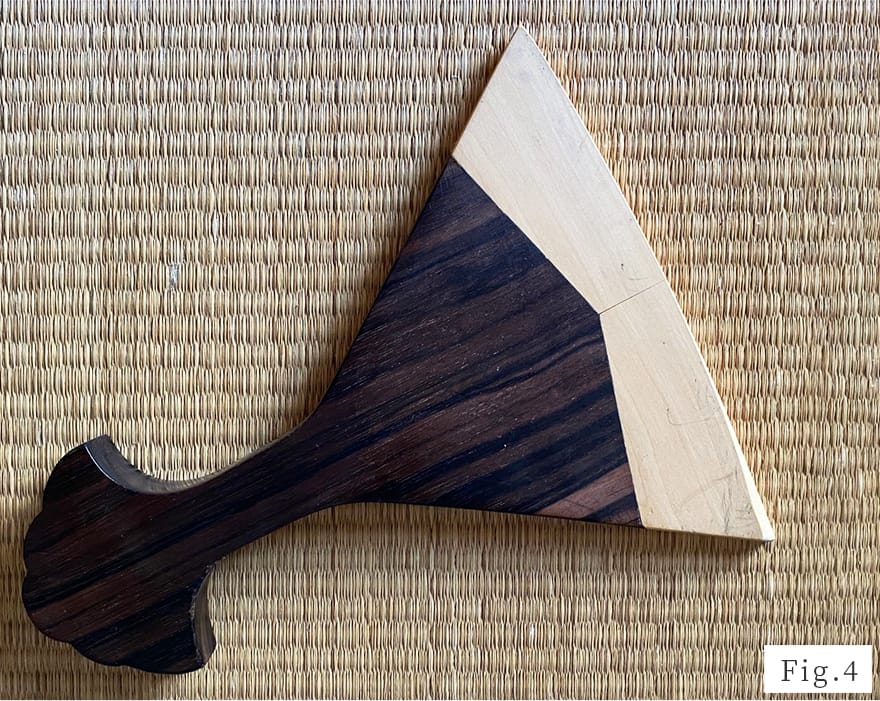
Different types of wood are used for the plectrum bachi (see Fig. 4). It is important, however, that the plucking tips are made from hard boxwood tsuge. Just as important as the material of the plectrum is its weight. A biwa-craftsman has the experience of how heavy a pick should be, based on the player's body weight and size. There are also valuable ivory plectrums, but the sound produced is hard and sharp and only suitable for a very bright female voice.
The strings are made of silk and are therefore have a short life, the highest string in particular often snapping. All five strings have different gauges, four of which are shared by all instruments regardless of size. Only the gauge of the fifth string, the melodic string, changes according to the vocal register: high female voices use thinner 5th strings and smaller biwa, and lower male voices use thicker strings and larger instruments. Pitch is not absolute, and each player is free to determine the pitch of the instrument. A male with a western tenor range normally would tune the first string to “A “or “B” while someone with a baritone range, such as this author, would tune the first string to A♭.
( A♭, E♭, A♭, B♭, e♭is the tuning used for the sound recordings).
2. String, Fret Distances,
Designations
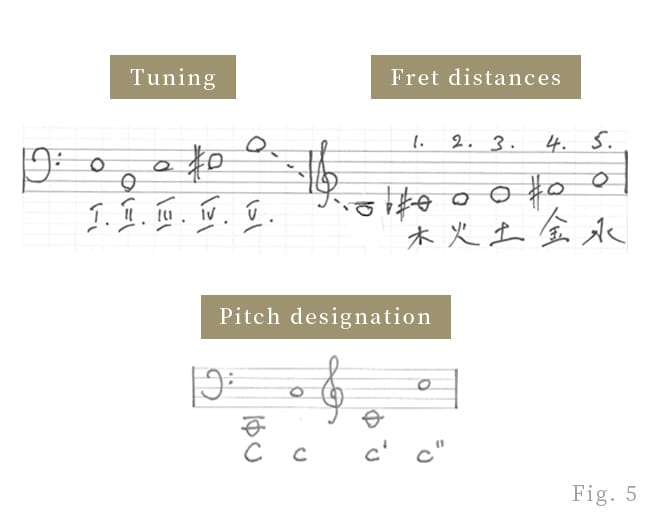
For clarity's sake, the relative pitch used here is the same as seen in the biwa article in the dictionary Nihon ongaku daijiten p.567.
Strings I and III are the same pitch: however, as the gauge is different, the resulting timbre differs. String I is thicker than string III and accordingly larger in volume. Normally, as this string is only struck in its open position, it thus also has a percussive quality. If a melody is to be played in the area above the pitch f#, strings III or IV are used in most cases, and string V is restricted to higher notes. Unlike the shamisen, there is only one tuning for the biwa.
The strings have no special names, but the five frets are named after elements:
1. = Wood 木 2. = Fire 火 3 .= Earth 土 4. = Gold 金 5. = Water 水
This designation of the frets goes back to the nomenclature used by the mōsō biwa players, which derives from the gogyō, the “Five Elements Theory” that originated in Ancient China. This theory states that all things in the world consist of the five elements: wood, fire, earth, gold and water. Buddhism also integrated this philosophy to a certain extent. The soundboard of some instruments lacked the two crescent moon sound holes as seen on all other biwa types, but had a crescent moon and a sun as the ideology of the mōsō biwa performers included the planets and the sun. According to this system of thought, the strings I through IV are named after the four seasons to complete the cosmic aspect of the instrument.
As mentioned briefly, the position of the 1st fret 木 is problematic. The indication given above of the fret distances seen in the Nihon ongaku daijiten and other dictionaries is not entirely correct as the 1st fret on all instruments is purposely positioned to produce a pitch that is too low or flat. This practice is also seen with the satsuma biwa and is not a defect, but arises from musical ‘sense'.
This first fret is very rarely required in interludes, and used to produce the pitch resulting from the intersection of fret and string. If this note is to be played (on the diagram, an f# starting from string III), the player needs little finger pressure - assuredly, more nuance when compared with other notes - in order to produce a pure pitch. Why this complication?
If all the interludes are analyzed, it turns out that the tones produced on this first fret are to be produced with a certain expressivity. They must convey a heightened emotion through slightly increased string tension. If the same pitch is to be produced in a relaxed manner, other fingerings are used. This detail clearly shows a close connection between the construction of the instrument structure and the music: the only music possible on the chikuzen biwa is chikuzen biwa music.
3. Playing Technique
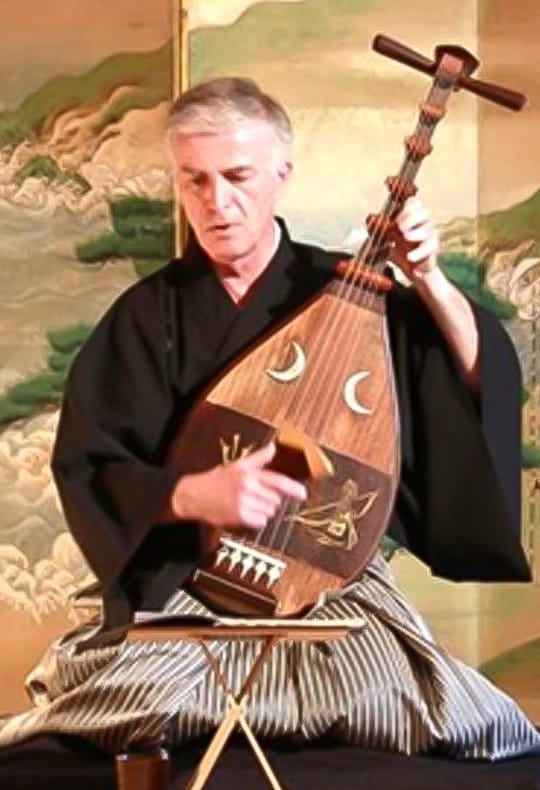
The traditionally correct playing posture is seiza, sitting with your legs folded underneath. Seiza is a formal, polite way of sitting in a floor-related culture that fundamentally had no chairs. Once the performer is accustomed to this posture while playing and singing, the advantages are clear (apart from the pain in your legs after playing for an extended period of time): seiza promotes abdominal vocalization, in which the performer uses the solar plexus for vocal production rather than the chest. Once this technique has been mastered, the performer is capable of producing a full, resonant, and relaxed voice for a long time, this voice being grounded on a column of air with a strong base in the solar plexus. The relaxation of the upper body, which rests with the rump on the heels of the performer, also allows the arms to relax. It is extremely important for the right arm to be completely relaxed in order to produce the full sound of the biwa for important accents.
As already mentioned, string I has a percussive character as no pitches are fingered here. The stroke on the open first string mostly serves to impart a sense of drive into the playing. Each time YAMAZAKI Kyokusui performed the most representative prelude, Hiraki ichi, she began with a powerful strike on the open string I (being not notated). It was this sound that immediately pulled the listener into the world of her biwa performance. The use of this single stroke is popular with all biwa players of the Tachibanakai and has become almost orthodox.
As mentioned above, according to the popular explanation of the instrument name biwa, there are two types of strokes in chikuzen biwa: “up” and “down” - “bi” and “wa”. The grip of the plectrum means that the thumb of the right hand is positioned close to the striking tip of the plectrum. This is important for the tactile sensation of the players - they feel as if they are touching the strings with an "extended thumb".
The strings are stopped with the left hand, whereby the finger presses the string down slightly between two frets. Pressing the string down on the fret itself would produce a muffled sound that cannot be modified. The frets of the chikuzen biwa are extremely high, and enable a differentiated finger pressure, and thus make possible the production of a variety of pitches. The fret height allows the melody string (string V) to be raised as much as a fifth by finger pressure. This technique is absolutely necessary because the instrument only has five frets and therefore only five pitches by simply laying the finger on the top of the fret alone. Since many different pitches are generated by the appropriate finger pressure, semitones can be produced as well as microtonal differentiations. In the music of the chikuzen biwa, the semitone levels can be “colored”: there is the “suffering” semitone (a little too flat), or the "defiant" (a bit tense, too sharp) etc. that relies upon the sensitivity and musical intentions of the performer. These subtleties are not explicitly taught by the teacher, but when the student produces them, they are appreciated.
The finger pressure not only allows to determine a precise pitch, but with slowly increasing or decreasing finger pressure the player can also produce small glissandi up and down.
The playing technique of the chikuzen biwa has been enriched by some elements from the shamisen playing technique. In some melody sequences, there is the option of plucking a string with the fourth finger of the left hand, or tapping the fourth finger on a fret to create a soft sounding pitch, and more.
Another specific playing technique that should be mentioned: striking the soundboard with the plectrum. This stroke must be performed gently in order to clearly distinguish it from the playing technique of the satsuma biwa. There, strokes on the soundboard are frequent and are often combined with a previous striking the strings. This technique sounds very “masculine” and raises images of sword blows or gunshots. With chikuzen biwa, the feminine counterpart to satsuma biwa, the stroke is elegant. But one must not forget that this purely percussive stroke in chikuzen biwa undoubtedly reflects the influence of satsuma biwa.

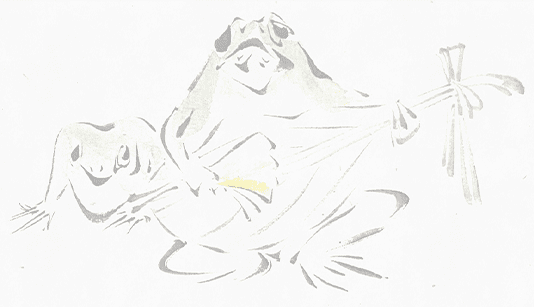
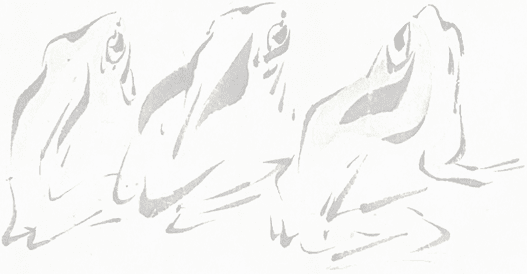
4. Instrumental Notation
All interludes for the ballads (there are no original independent instrumental pieces) are noted in a play book (danpōbon) and must be memorized as only the name of an interlude is indicated in the ballad text (see Fig. 7).
The instrumental notation of the Tachibanakai is based on the tradition of the ancient satsuma biwa (seiha). It is a tablature not unlike the lute tablature of the early baroque period. There is, however, no historical West-East connection between these notation cultures. A tablature is designed solely to inform the player of the correct fingering and technique, and does not follow the logic of a tonal system by representing pitch. The five horizontal lines correspond to the five strings of the instrument, the top line representing the first string and the bottom line the fifth melodic string with the highest pitch. The explanation for this is the performance posture: the biwa is held at a slight angle to the performer's left. The string sequence is therefore identical with the tablature: the top line refers to the low-sounding first string.
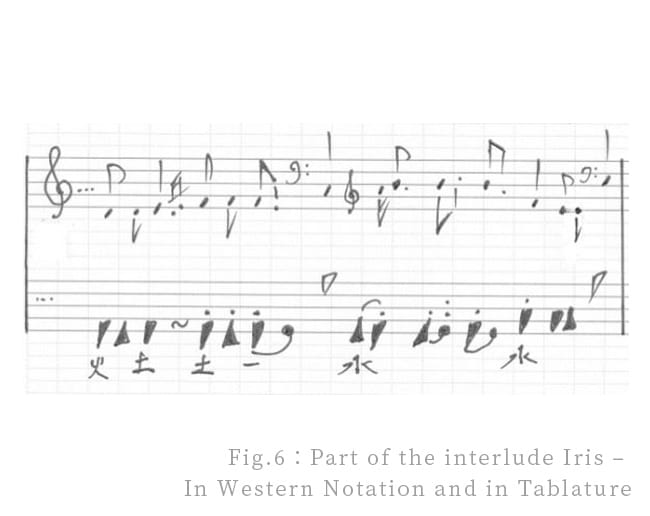
The strokes with the plectrum are marked with elongated black triangles. If the narrow-angled tip points downwards, a downward strike called hiku is required: if it points upward, it requires an upstroke pluck called hajiku. (As already explained, the Chinese characters for wood, fire, earth, gold and water are used to denote the fret.)
Increases of a semitone or a whole tone are indicated by dots placed above the triangle: two dots above the triangle indicate a whole tone or a minor third and three points a major third. A white triangle means a beat on the corresponding open string. In the music example Fig. 6 from the interlude Iris, the 5th string is pressed down at the “fire”-fret 火, which results in the sound d'. It is followed by the sound e' produced on the “earth” fret土. The added dot on the next triangle asks for finger pressure in order to produce f'. The last note is a strike on the open 1st string E.
The tone duration is graphically represented by the distances between the triangles. Oral instruction is definitely needed to grasp the rhythmic shape of an interlude. This imprecisely defined tone duration design (in contrast to the absolutely unambiguous fixation of pitch) unquestionably corresponds to the flexible metric feeling. For example, chikuzen biwa players do not differentiate between a duple or a triple rhythm, and it is logical that the notation does not take such distinctions into account.
5. Vocal Notation
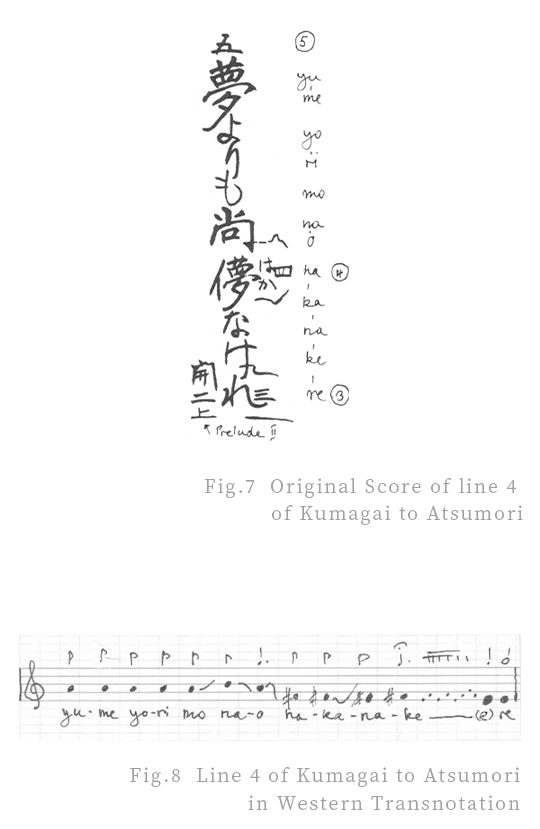
Outside of the first and final pages of a composition, the pages of the ballad textbooks contain six vertical lines, each of which is sub-divided into an upper and lower section of twelve syllables each, these sub-divisions constituting metered lines. Each twelve-syllable line follows Japanese poetic practice and can be further sub-divided into seven plus five syllables. Thus, one page actually has 12 independent lines. The example here(Fig. 7) is line 4 from the ballad Kumagai to Atsumori: Yume yori nao hakanakere. The numerals of the vocal notation are based on the fret's number and the intersection: fret / V. string. Therefore the vocal pitches are: ①c#', ②d', ③e', ④f#', and ⑤a'. The number at the beginning of each line indicates the pitch on which the singer should start singing. In the example given, the singer starts with pitch ⑤ or a'.
Of course, the design of the vocal meandering is important. It is only indicated with lines and dots that resemble the neumes of Gregorian chant, which for the singer indicate clear pitch and metric structure. Theses neumes are called fushi.
If the sung line is followed by an interlude, its title is displayed at the bottom left at the end of the line. In the quoted line 4 from Kumagai to Atsumori the interlude is: 開二上 Hiraki ni no jō: First half of Prelude II.
